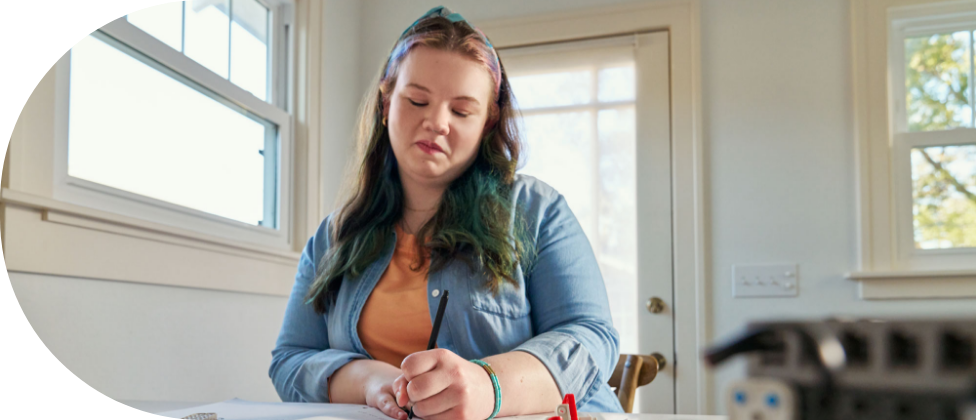Hear from people living with narcolepsy and treating with LUMRYZ
Learn about their experiences being diagnosed with narcolepsy and their journey to starting LUMRYZ
Individuals featured have been compensated by Avadel Pharmaceuticals. Individual results may vary.
Katie
While in college, Katie struggled with symptoms of excessive daytime sleepiness (EDS) and routinely taking the second dose of a twice-nightly sodium oxybate.

Katie’s Story
Katie:
My name is Katie and this is my narcolepsy story.
My onset started in high school. I was in marching band, orchestra, concert band, and robotics. I had a part-time job. And so I had been running myself ragged doing every activity possible, so I don’t think anyone thought twice that I was maybe getting burnt out a little bit and sleeping more my senior year.
I was not recovering from that burn out. I kept getting sleepier. It became this voice I couldn’t ignore, telling me “I need to go to sleep. I’m too tired to be here right now.” I’m not missing these activities because I’m not interested in them anymore—I’m missing these activities because my body’s telling me I have no choice but to sleep.
I saw an ad come up on TV and it was talking about excessive daytime sleepiness, and I was like, “No way.” We set up an appointment with a sleep specialist. I was kind of done advocating for myself. I’d fought this fight—I’m going to let someone else fight it for me. And it was just medication after medication.
I had a nurse practitioner for one of my appointments and she’s like, “Why haven’t you tried twice-nightly sodium oxybate?” I was like, “Absolutely, I’ll try.” But it’s extremely rare that I could wake up on time to an alarm going.
When I would wake up realizing I hadn’t taken that second dose, I had to start crunching numbers. What time is it now? If I take the dose now, will I wake up in time for class? Or, do I skip this dose to ensure I can wake up on time? But I’m probably not going to make it through to my afternoon classes. When I missed my second dose, I’m drifting off, I’m losing focus, I’m nodding off in class.
When I was taking twice-nightly, it felt like a “Me” problem, like I hadn’t found the right alarm, I hadn’t tried hard enough. You start losing hope as you realize like, “Oh, maybe there isn’t a treatment for me. Maybe I just have this thing and I have to live with it exactly as it is from here on out.”
Once I got on to LUMRYZ, I could see that hope again.
Once-at-bedtime LUMRYZ for me means I go to sleep and the only thing I have to think of is what I’m going to be doing the next day. I’m not exhausted. I’m awake enough to do things like make myself breakfast. It wasn’t until maybe six or seven months on LUMRYZ that I genuinely realized that my commute was 20 minutes. That’s how much it was impacting me to drive while sleepy.
With LUMRYZ, I’m ready to get to class. Feeling awake in class, for me, means being able to participate. I’m learning about things I really enjoy. I’m not having an internal conversation with myself trying to stay awake.
That was just my experience. Yours may be different, and you should definitely go talk to a health care professional for any questions you have.
Since taking LUMRYZ, because I am more awake during the day, I am able to bring up the next generation of robotics kids. If someone out there is struggling, I would tell them that it’s not something that you have to deal with on your own. I want to tell people that there are options. This is not a hopeless situation.

Tyler
Tyler dealt with persistent cataplexy and EDS, because he struggled with consistent dosing on his twice-nightly narcolepsy medication. After discussing his experience and the impact on his symptoms with his healthcare provider, Tyler switched to once-at-bedtime LUMRYZ. See Tyler’s experience with LUMRYZ.
Tyler’s Story
Tyler:
My name is Tyler and I am from Williamsport, Pennsylvania.
It’s a big sports town. Played a ton of soccer, a ton of basketball. Both high school and travel sports as well. I started noticing having symptoms for my narcolepsy when I was in eighth grade. Even when I would sleep a full 8, even sometimes 10 hours, I would still fall asleep the next day in class and take naps. Two minutes into a basketball game, I would start feeling the symptoms and my performance would go down. My muscles were fatigued. It felt like jelly.
My mom mentioned after soccer practice, my friends would play outside and I would go take a nap on the couch. And I think that kind of sparked something in my family doctor’s mind—I went and got an overnight sleep study, and then the results pretty much came back soon after that I had narcolepsy with cataplexy.
My treatment story started with twice-nightly sodium oxybate. I did notice an initial change. I remember I could read my history textbook. I read like a whole chapter without having to take a break or without falling asleep. The issue with that was every night my mom would wake up to make sure that I took the medicine because it was really hard for me to wake up in the middle of the night. Now suddenly having to, like, solely rely on one person every night to make sure that I felt well the next day would really bother me a lot.
I was very vocal, about how difficult it was to wake up every single night to make sure I took my medicine.
I learned about once-at-bedtime LUMRYZ from my neurologist. LUMRYZ allowed me to set my own sleep schedule because I didn’t feel like I was hindering anybody and the packets are already measured for me beforehand. Since taking once-at-bedtime LUMRYZ, I feel more awake to engage with my friends and play games with them or watch movies or go out to eat.
With LUMRYZ my symptoms of cataplexy have been mitigated. I’m now able to play full games of basketball and full games of soccer. Since taking once-at-bedtime LUMRYZ I feel more awake to engage in class. Now I don’t really have to try any of my different techniques to stay awake. I used to like, drink water during class or kind of pinch myself. Even to the extremes of like stabbing myself with a pencil. I’m able to do homework, which a lot of the times in the past I wouldn’t be able to just due to being very sleepy.
Insurance and co-pays and prior authorizations are extremely confusing, especially because now I’m a college student. I kind of mostly take care of my like health insurance and my medication process alone. RYZUP has been great at kind of guiding me through that process. They also make sure that I get ahead of when I need my medicine and that my delivery is scheduled.
A lot of the times with narcolepsy, things can seem so bland and tired. But when you take medications, such as LUMRYZ, that can help get back a lot of your life that you would have wasted away sleeping, it can be a very motivating thing and it can be something to look forward to.
Wendy
Wendy faced many challenges on the road to a diagnosis of narcolepsy with cataplexy. Learn how she persevered, and more about Wendy's journey to treatment.

Wendy’s Story
Wendy:
I’m Wendy from Collinsville, Illinois.
Originally, I had an episode when I was 12. It went from the best day of my life to the worst in seconds. And then didn’t have it again for almost 25 years. Then I’m at school and not feeling right. I’m anxious over testing and finals and all of a sudden my muscles couldn’t be controlled. My daughter got me to the hospital and they didn’t know what it was. Employers would not recognize the hard work I would do because, well, she takes a nap. She really doesn’t want to be here if she can’t stay awake for a full shift.
I even went to a psychologist who said, There’s nothing really wrong with you. You just need to convince yourself nothing’s wrong. When people don’t believe my symptoms, it’s so much frustration. It’s anger. It’s heartache. I went months and years without knowing what I had.
In 2011, I was told, you have narcolepsy. Three different medicines over maybe two years total. I could stay awake—but staying awake meant being in a fog all the time, and at that point I gave up. For three months, I did not leave my house, not even to walk the 50 feet to the mailbox. All I did was sleep…until I got tired of sleeping.
When I learned that there was something out there that would treat the symptoms of both cataplexy and excessive daytime sleepiness, I couldn’t have called the sleep specialist fast enough.
He said, “I’ll put you on this medicine. You take it at night. You get up 2 and a half to 4 hours later, take it again.” I say, let me call you every night at 2:00 in the morning and see if you like getting woken up and how easy it is for you to go back to sleep.
I needed another option besides twice-nightly.
Since starting once-at-bedtime LUMRYZ, I feel less sleepy and more awake. I love to get up in the morning and read and write. And I can paint—I don’t worry about falling asleep and ending up with paint all over my hands and my clothes. I can fully be in that moment.
I’m not worried that when I laugh…I’m going to immediately have a cataplexy episode. So I like to laugh a lot now.
These are my experiences and it’s so important to talk to your doctor about LUMRYZ and your choices and if it’s right for you.
The era before LUMRYZ is like looking at my family through gauzy curtains. And now the curtains have been pulled back. I can spend time with my husband, I can watch a movie with him and not fall asleep.
There’s still a whole world of me that I want to show everyone.
Are you taking LUMRYZ to treat cataplexy or EDS and interested in sharing your story with others?
If you’re a US resident and 18 years or older, please call the number below to learn more about the LUMRYZ Ambassador Program.
Visit the resources section for more educational materials and tools for talking to your healthcare provider.